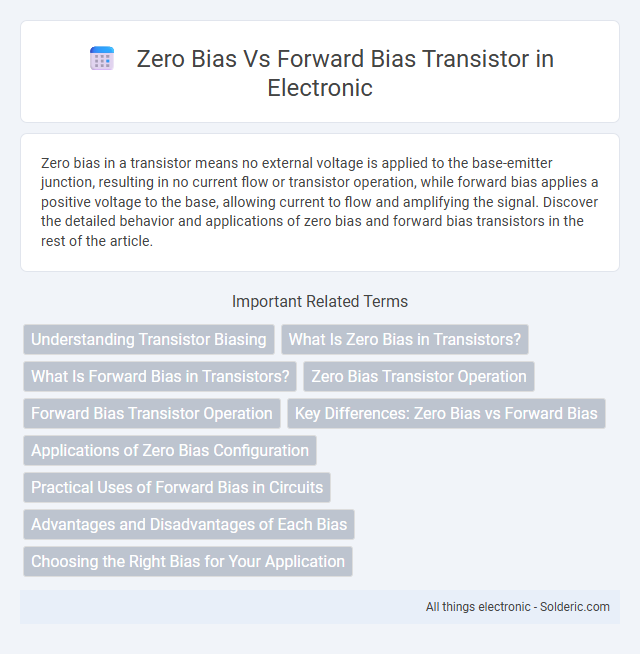Zero bias in a transistor means no external voltage is applied to the base-emitter junction, resulting in no current flow or transistor operation, while forward bias applies a positive voltage to the base, allowing current to flow and amplifying the signal. Discover the detailed behavior and applications of zero bias and forward bias transistors in the rest of the article.
Comparison Table
| Feature | Zero Bias | Forward Bias |
|---|---|---|
| Definition | No external voltage applied to the transistor junction | Voltage applied in the direction that allows current flow through the transistor junction |
| Junction Behavior | Junction remains non-conductive | Junction becomes conductive |
| Current Flow | No current or negligible leakage current | Significant current flows across the junction |
| Base-Emitter Voltage (V_BE) | Approximately 0 V | Approximately 0.7 V for silicon transistors |
| Use Case | Transistor off state or cutoff region | Transistor on state or active region |
| Collector Current (I_C) | ~0 A | Controlled by base current, substantial value |
Understanding Transistor Biasing
Transistor biasing controls the operating region by applying specific voltages to the transistor terminals, where zero bias means no external voltage is applied, causing the transistor to remain off or in cutoff mode. Forward bias applies a voltage that allows current flow through the base-emitter junction, activating the transistor and enabling signal amplification or switching. Understanding these biasing conditions is essential for optimizing your transistor circuit's performance and ensuring proper device operation.
What Is Zero Bias in Transistors?
Zero bias in transistors refers to the condition where no external voltage is applied between the transistor's terminals, resulting in no current flow through the device. In this state, the transistor remains inactive as the base-emitter junction is not forward biased, preventing charge carriers from moving. Your circuit stays in an off state under zero bias, which is essential for controlling transistor switching behavior in electronic applications.
What Is Forward Bias in Transistors?
Forward bias in transistors occurs when the base-emitter junction is supplied with a voltage that makes the base more positive than the emitter, allowing current to flow easily from the emitter to the base. This condition reduces the barrier potential, enabling charge carriers to move across the junction and activate the transistor's conduction. Understanding forward bias is essential for controlling your transistor's operation in amplifying or switching electronic signals.
Zero Bias Transistor Operation
Zero bias transistor operation occurs when the base-emitter junction is not externally biased, resulting in no significant current flow through the transistor. In this state, the transistor remains in the cutoff region because the lack of forward bias prevents charge carriers from crossing the junction, thus the transistor behaves like an open switch. Understanding zero bias conditions is essential for analyzing transistor switching characteristics and ensuring proper circuit functionality.
Forward Bias Transistor Operation
Forward bias transistor operation occurs when the base-emitter junction is forward biased, allowing current to flow easily from the emitter to the base. This reduces the barrier potential and enables electrons to inject from the emitter into the base, facilitating the flow of larger current from collector to emitter. The transistor operates in active mode, amplifying the input signal by controlling the collector current through base current modulation.
Key Differences: Zero Bias vs Forward Bias
Zero bias in a transistor occurs when no external voltage is applied to the base-emitter junction, resulting in no current flow through the device. Forward bias applies a positive voltage to the base relative to the emitter, enabling current to flow and allowing the transistor to conduct and amplify signals. The key difference lies in the base-emitter voltage condition: zero bias means the junction is not active, while forward bias activates the junction for transistor operation.
Applications of Zero Bias Configuration
Zero bias configuration in transistors is primarily utilized in radio frequency (RF) applications, such as detector circuits and signal demodulation, where minimal power consumption is essential. It enables the transistor to operate as a passive component, effectively detecting weak signals without the need for external biasing voltage. This mode is particularly advantageous in simple, low-cost designs like crystal radios and some types of analog switches.
Practical Uses of Forward Bias in Circuits
Forward bias in transistors is crucial for enabling current flow through the device, making it essential for switching and amplification in practical circuits. Your electronic designs commonly rely on forward-biased transistor junctions to control signal flow and power regulation in applications like audio amplifiers, voltage regulators, and digital logic circuits. Zero bias conditions typically serve testing or cutoff functions but do not support active circuit operation where forward bias is required.
Advantages and Disadvantages of Each Bias
Zero bias in transistors offers low power consumption and minimal heat generation, making it ideal for signal detection and high-frequency applications, but it suffers from limited current amplification and slower switching speed. Forward bias provides high current gain and faster switching, which enhances transistor performance in amplification circuits; however, it increases power dissipation and heat production, potentially reducing device longevity. Choosing between zero bias and forward bias depends on the trade-off between power efficiency and amplification capability in specific electronic designs.
Choosing the Right Bias for Your Application
Zero bias in transistors means no external voltage is applied to the base, resulting in the transistor remaining off and blocking current flow, ideal for switching applications that require no conduction until activated. Forward bias involves applying a voltage to the base-emitter junction, allowing current to flow and the transistor to operate in its active region, which is essential for amplification and linear signal processing. Your choice between zero bias and forward bias depends on whether you need the transistor to act as an on/off switch or as an amplifier within your circuit design.
Zero bias vs Forward bias transistor Infographic

 solderic.com
solderic.com